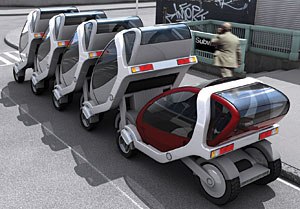For too long, too much of the discussion about urban mobility and its relationship to sustainability has been locked into an increasingly sterile debate between proponents of public transit and advocates of the automobile. Both sides ignore some inconvenient truths.

Transit enthusiasts point out the inherent efficiencies of high-capacity public-transportation networks, but often neglect to mention that, under most practical circumstances, they offer no solution to the “last-mile” problem. They can get you to approximately where you want to go approximately when you want to get there, but rarely exactly. You still have to get from the nearest transit stop to your actual destination. It is nice to imagine that this problem could be handled by clustering high-density development within convenient walking distance of transit nodes, and sometimes it can—at least partially. But this is far from a general solution. Often, circumstances conspire against it: The distances are too great; it’s impractical for the aged, small children, and the physically impaired; it can expose you to a variety of dangers; it’s unattractive in rainy, snowy, very cold, or very hot weather; and it just doesn’t work if you have a lot of stuff to carry.
Defenders of the private automobile emphasize that it provides mobility on demand, there are no timetables for its use, and it gets you right to your destination. As a result, people really like their cars—not only for the convenience they offer and their elimination of the “last mile,” but also because they function as powerful emblems of personal freedom and social status. Furthermore, the economic, social, and cultural vibrancy of cities depends upon dense, convenient, unrestricted interconnectivity, and automobiles have become universal agents of this.
The problem with cars, which has become increasingly evident as their popularity has grown, is that the scale effects and externalities come back to bite you. When there is an extensive road network with few vehicles on it—as, for example, on the Los Angeles freeway system late at night, it’s indeed astonishingly quick and easy to get around. But when the network becomes choked with traffic, congestion and delays begin to negate the automobile’s advantages. Automobiles account for huge percentages of the energy consumption of cities, producing economic and geopolitical problems in the short term and a significant threat to sustainability in the long term. Tailpipe emissions turn out not only to produce local pollution, but also to contribute to global warming.
In my Smart Cities group at the MIT Media Laboratory, we have been developing a third option—a clean, compact, energy-efficient City Car that promises high levels of personal mobility at low cost, and effectively complements transit systems by, among other things, efficiently solving the “last-mile” problem. This project illustrates the growing potential of ubiquitously embedded intelligence and networking to revolutionize the ways we design and operate buildings and cities.
The crucial enabling technology of the City Car is an omnidirectional robot wheel that we have developed. This wheel contains an electric-drive motor, suspension, steering, and braking. There are no mechanical linkages connecting the robot wheels to the driver’s controls. In other words, the car is fully drive-by-wire, with just an electric cable and a data cable going into each wheel, which has a simple, snap-on mechanical connection to the chassis.
Elimination of the traditional engine and drive train enables modularization of the mechanical systems and offers great flexibility in design of the body and interior. We have taken advantage of this to create small, lightweight passenger vehicles that fold and stack like shopping carts at the supermarket or luggage carts at the airport.
The independent, omnidirectional wheels provide extraordinary maneuverability: Cars can spin on their own wheelbases instead of making U-turns, and can parallel park by slipping in sideways. Depending on context, six to eight folded and stacked City Cars can fit in one traditional parking space.



Post a comment to this article
Report Abusive Comment